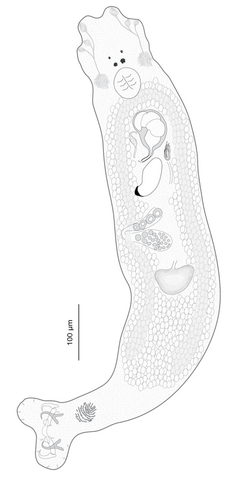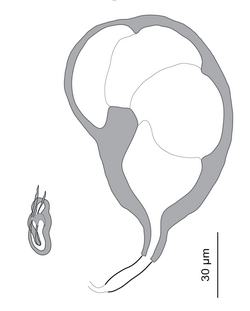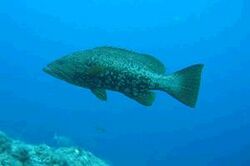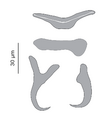Biology:Pseudorhabdosynochus regius
| Pseudorhabdosynochus regius | |
|---|---|

| |
| Pseudorhabdosynochus regius | |
| Scientific classification | |
| Domain: | Eukaryota |
| Kingdom: | Animalia |
| Phylum: | Platyhelminthes |
| Class: | Monogenea |
| Order: | Dactylogyridea |
| Family: | Diplectanidae |
| Genus: | Pseudorhabdosynochus |
| Species: | P. regius
|
| Binomial name | |
| Pseudorhabdosynochus regius Chaabane, Neifar & Justine, 2015
| |
Pseudorhabdosynochus regius is a diplectanid monogenean parasitic on the gills of the mottled grouper (Mycteroperca rubra).[1]
Etymology
The specific epithet, regius, is from the Latin adjective meaning "royal". It was given in reference to the French name of the type-host, Mérou royal.[1]
Description
Pseudorhabdosynochus regius is a small monogenean, about 600-1300 µm in length. The species has the general characteristics of other species of Pseudorhabdosynochus, with a flat body and a posterior haptor, which is the organ by which the monogenean attaches itself to the gill of is host. The haptor bears two squamodiscs, one ventral and one dorsal, which are small, with a length of 20-40 µm, and made up of only 10-11 rows of rodlets.
The sclerotized male copulatory organ, or "quadriloculate organ", has the shape of a bean with four internal chambers, as in other species of Pseudorhabdosynochus.[2] The vagina includes a sclerotized part, which is a complex structure, 26-35 µm in length. It exhibits a trumpet in continuity with the primary canal, a straight primary canal, and primary and secondary chambers included in a common sclerotised mass along the primary canal. The sclerotised vagina is the structure used by systematicians to differentiate species of Pseudorhabdosynochus. The closest relatives of P. regius, based on the structure of its sclerotised vagina, are species mostly found in the Mediterranean Sea and parasites on species of Mycteroperca.[1]
Hosts and localities
The type-host of Pseudorhabdosynochus regius is the grouper mottled grouper (Mycteroperca rubra) and the species has not been found in another host. The type-locality if off Dakar, Senegal. The monogenean has also been found on fish of the same species caught off Sfax, Tunisia and off Tripoli, Libya. Thus, P. regius is known from the Mediterranean Sea and the Eastern Atlantic. Only 14 species of diplectanids parasitic on groupers are known in the Mediterranean Sea and P. regius is one of them.[1]
Gallery
Sclerotised vaginae of various specimens
Hard parts of the haptor
Ventral squamodisc
References
- ↑ 1.0 1.1 1.2 1.3 Chaabane, Amira; Neifar, Lassad; Justine, Jean-Lou (2015). "Pseudorhabdosynochus regius n. sp. (Monogenea, Diplectanidae) from the mottled grouper Mycteroperca rubra (Teleostei) in the Mediterranean Sea and Eastern Atlantic". Parasite 22: 9. doi:10.1051/parasite/2015005. ISSN 1776-1042. PMID 25674913.

- ↑ Kritsky, D. C. & Beverley-Burton, M. 1986: The status of Pseudorhabdosynochus Yamaguti, 1958, and Cycloplectanum Oliver, 1968 (Monogenea: Diplectanidae). Proceedings of the Biological Society of Washington, 99, 17-20. PDF

Wikidata ☰ Q19595152 entry
 |







